Canon EF 16-35mm f/4L IS USM Review
Ultra wide angle rectilinear lenses are one of my favorite playgrounds for creative photography. The extremely wide angle of view introduces distortion to the image that is completely foreign from who we normally see the world. That effect can be put to creative use in many ways: from simply capturing more of the environment in a single image, to transforming the mundane into something that’s truly bizarre and interesting.
For the longest time Canon’s full-frame ultra-wide-angle zoom lens situation was carried by the EF 16–35mm f/2.8L USM and the EF 17–40mm f/4L USM lenses. The choice between the two largely came down to picking whether you needed the faster aperture for active subjects, or couldn’t afford the f/2.8 lens.
However, in the grand scheme of things, neither were really great options. Both suffer from soft corners and other image quality maladies. Until recently, Canon’s wides have been the weakest part of their lens lineup. They’re certainly passable, but they’ve never shown the real brilliance that, say, Nikon’s wides have.
The EF 16–35mm f/4L IS USM changes the Canon wide-angle lens story—for the better.
Build
Size and weight aren’t the best indicators of build quality, but combined they can shed some light on how well something is built. Even though the EF 16–35mm f/4L IS USM sheds a stop of aperture and has the same number of elements and group as the EF 16–35mm f/2.8L II USM (16 elements in 12 groups), the size and weight are very close to those the faster lens.
The diameter and length of this lens is 3.25 x 4.44 inches (82.6 x 112.8 mm), compared to the f/2.8L II’s 3.5 x 4.4 inches (88.5 x 111.6 mm). Weight wise, the EF 16–35mm f/4L IS USM weighs 21.7 ounces (615 g), compared to the f/2.8L II’s 22.4 ounces (635 g). So the EF 16–35mm f/4L IS USM is slightly smaller in diameter and slightly longer, and just under an ounce lighter (0.7 ounce to be exact).
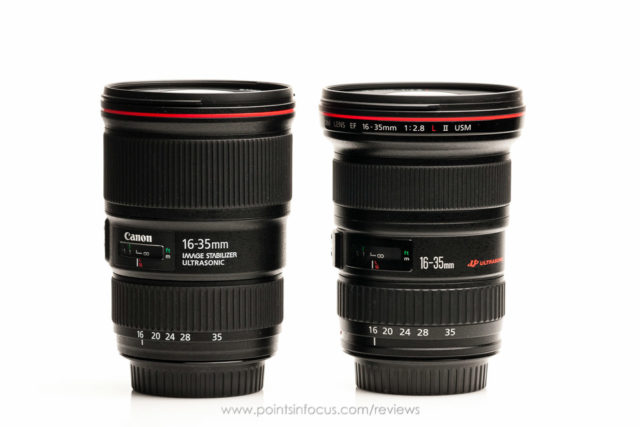
Side by side there’s really not much of a difference between the two lenses in weight or size. Actually, in some ways the f/2.8 lens looks, a little trimmer as it’s thinner for the majority of its length and only flares out at the end. The most noticeable differences in size are in the front filter ring and the new hood.
The EF 16–35mm f/4L IS USM follows the most common design for ultra-wide-angle zooms. Instead of having an barrel that extends when you zoom, all the moving parts are contained inside a singled outer barrel. However, unlike say a 70–200mm zoom, the front element of the EF 16–35mm f/4L IS USM moves when zoomed.
The overall build quality is quite spot on for a Canon L lens. The finish is the same hard black textured finish that Canon has been using for years. In my experience, the finish is highly resistant to marring and scratching and seems to be quite durable.
I can’t precisely identify the material of the outer lens barrel, or at least the few ares that aren’t rubber grip covered control rings. Tapping on it sounds like plastic or maybe very thin metal. Either way, it sounds the same as my EF 16–35mm f/2.8L II USM or my EF 24–70mm f/2.8L USM to my ear, and both those lenses are quite durable so I would expect the EF 16–35mm f/4L IS USM to be the same.
The filter threads and hood mount appear identical in material and finish to those on the EF 16–35mm f/2.8L II USM. Again, I’m not entirely sure what that material is; however, if it’s the same as the material on the EF 16–35mm f/2.8L II USM, I’m not expecting any issues.
Weather Sealing
The EF 16–35mm f/4L IS USM, like the rest of its L contemporaries, is designed to be resistance to dust and water intrusion. Quoting from the manual:
Tight seal structure ensures excellent dustproof and drip-proof performance.
Since the front element moves when zooming, you need to attach a Canon PROTECT filter sold separately for adequate dust- and water-resistant performance. Without a filter, the lens is not dust and water resistant.
The short of it here, is that as long as you have a protective filter on the lens you’re good to go against drops and dust. I should also point out that while Canon suggests using their PROTECT filters, their 77mm PROTECT filter is 5mm thick and will cause more vignetting issues than a slim 3rd party alternative (see the filters section for more details).
The most visible indication of weather sealing is, of course, the black gasket around the outside of the lens mount.
All told, I don’t see any glaring issues where the weather resistance of this lens should be any worse than the resistance of any other Canon L lens.
Hood
Hoods on wide and ultra-wide angle lenses generally aren’t good for much in the way of protection or shading. The angle of view they have to deal with is just too wide for the hood to be very deep. Interestingly, the EW–82 hood for this lens doesn’t seem nearly as useless as say the hood for the EF 16–35mm f/2.8L II USM or the EF-S 10–22mm f/3.5–4.5 USM, perhaps because it doesn’t flare out so dramatically. That said, it’s still not going to offer a lot of protection to the front element.
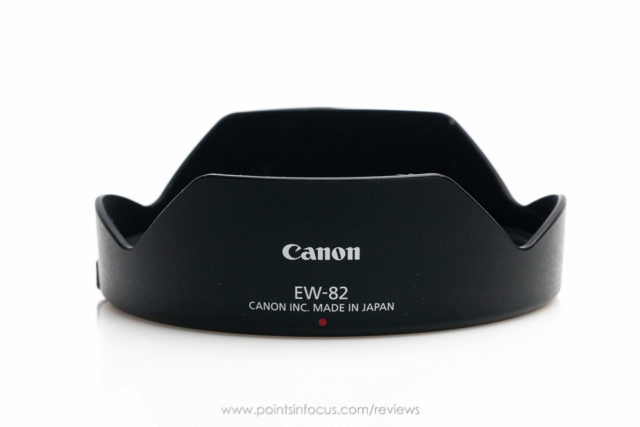
The biggest upgrade point in the hood is that it uses Canon’s current push button locking hood design instead of the old friction fit method. Friction locks have always given me trouble eventually. As time goes on, the locking nibs and the lens’s bayonet mount wear and the lock becomes looser. I have some lenses, where ultimately I have to gaffer tap the hood in place to keep it from falling off at an inopportune time. The button lock eliminates that wear issue completely, and it’s going anywhere unless you hit the release button.
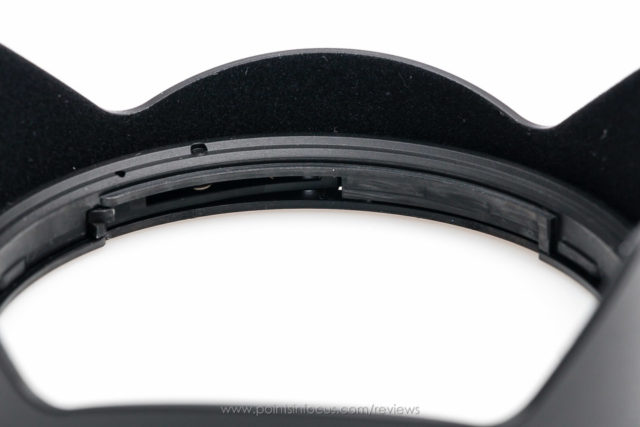
This hood, as well as the other button locked Canon hoods, doesn’t have a preferred orientation. The locking mechanism will secure the hood properly regardless of which orientation or whether the hood is in the stowed or use positions.
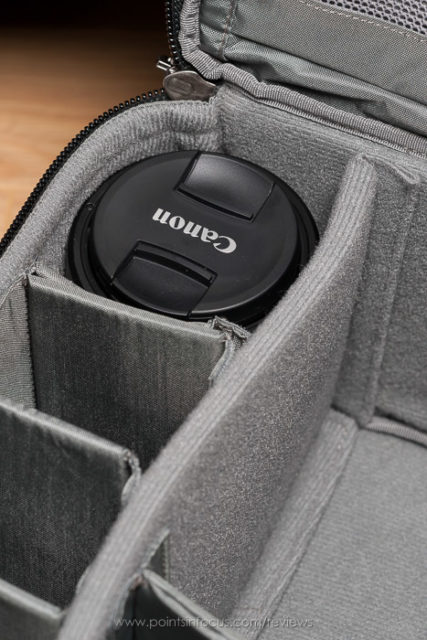
The other place where the EW–82 hood stands out as being excellent is stowed in the bag. I know it sounds weird, but compared to the EW–83 hood from the EF 17–40mm f/4L USM and EF-S 10–22mm f/3.5–4.5 USM, or the EW–88 of the EF 16–35mm f/2.8L II USM; the hood on this lens just fits in every bag I own better. Again, I attribute this largely to the lack of significant flare in the design.
One final nice feature of the hood is that the two largest pedals are flat, so you can sit the lens on end on the hood and it will stand up instead of tipping over like the EF 16-35mm f/2.8L IS USM did.
Filters
Filters are certainly something that’s decorated in usage with the rise of digital photography and the associated processing it enables. However, while some filters can be eliminated on account of technology, such as color correction, there are still effects that are best done with filters instead of software. Polarization, long exposures, and diffusion are the big 3 that come to mind.
For the most part, talking about filters is a waste of time. On most lenses, the angle of view is narrow enough that even thick filters or stacks of filters, won’t cause any noticeable vignetting. Ultra-wide-angle lens, however, is one big case where that isn’t true. The wide angle of view combined with the typically tight tolerances makes filter driven vignetting a real concern.
Since the filter ring is part of the outer lens barrel, the 77mm filter mount on the EF 16–35mm f/4L IS USM doesn’t move or rotated when the lens is zoomed or focused. This of course is expected of ra professional grade lens, and it means creative filters such as split ND grads and polarizers can be used easily.
Moreover, the 77mm mount means the EF 16–35mm f/4L IS USM shares a common filter size with most of Canon’s L zooms. The exception is the 82mm of the EF 16–35mm f/2.8L II USM and EF 24–70mm f/2.8L II USM, and the 67mm filters of the EF 70–200mm f/4L USM and EF 70–200mm f/4L IS USM.
That said, thick filters are certainly problematic on ultra-wide-angle lenses. A standard 5mm thick protection filter, or 7mm thick polarizer will vignette on the lens noticeably when it’s zoomed to 16mm. A thin, 3mm, protection filter, like the B+W XS-Pro series, works much better.
The filter vignetting situation extends to the polarizers too. While polarizers aren’t as useful with ultra-wide angle lenses due to the differential darkening they create in skies, they still can be useful in removing shine from leaves and reflections from water in scenes without sky in them. The filter vignetting situation still applies though, and a thin polarizer is necessary — again, something like the 5mm thick B+W XS-Pro — will help minimize corner vignetting. Though even at 5mm there will still be vignetting at 16mm form the filter.
Rectangular Filter Systems
For creative effects, including neutral density and ultra-wide angle lenses can be problematic. Serious users typically use 4 inch (100mm) wide filters from the likes of Lee or Cokin. For most lenses, these are wide enough to not have the holders show up in the periphery of the frames. However, when you get down around 16mm, the angle of view is wide enough to start revealing the holder unless extreme caution is taken.
At 16mm a Lee wide-angle adapter mounted directly to the lens will show some vignetting, but it’s slight enough to be acceptable in my opinion. Moreover, with only two slots in the holder, there’s some corner issues when the slots are rotated about 30° to the long axis of the frame.
With a thin protection filter in place, the vignetting situation deteriorates some but not as much as I had expected. The most obvious place where things go really south is when the Lee holder is rotated out of alignment with the long eye of the frame, where there is extremely noticeable clipping.
All that said, there is one very important caveat to keep in mind here. I do my vignetting testing at the focal length that nets the widest apparent angle of view. In the case of the EF 16–35mm f/4L IS USM, the field of view appears to be the widest at the close focus distance. In the end, this shows the worst case vignetting, but probably isn’t all that indicative of what you can normally expect to see when focusing at infinity or some where closer to that.
With that in mind, the image below takes the last of the previous cases, a 3mm XS-Pro filter + the Lee wide-angle ring + a 2 slots in the lee filter mount rotated about 30°, and shows the interference when the lens is focused at infinity.
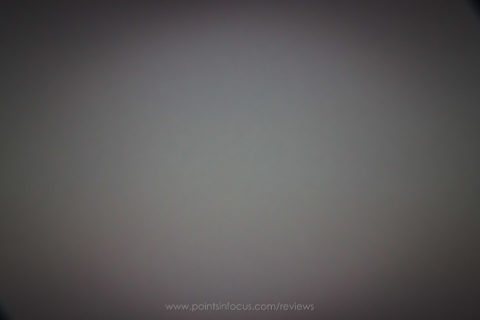
Handling, Zoom and Focus
The EF 16–35mm f/4L IS USM follows the standard design for professional zooms, there are two control rings, one for focus and the other for zoom. These two rings are largely equal in size, and the focus ring placed at the front of the lens and the zoom ring place close to the lens mount.
Personally, I find this arrangement less than idea. I find the rear positioning of the zoom ring means I end up choking up on my grip which reduces my ability to maximize my stability when holding the camera. Moreover, I find I frequently end up bumping the focus ring accidentally while trying to adjust my grip to maximize my stability and comfort. I find the problem is compounded on ultras-side angle zooms, as they tend to have the zoom ring even closer to the mount than mid-range professional zooms do.
All told, I’m increasingly finding that I would prefer to have the zoom and focus rings reverse while maintaining the same nearly equal sizes.
Focus Ring
The focus ring on the EF 16–35mm f/4L IS USM is the forward most control ring on the lens. Overall it’s 1–3/8 inches wide with 1–1/8 inch of that rubberized.
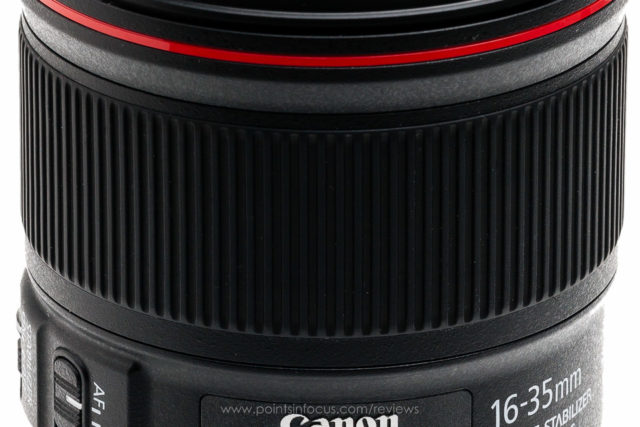
The entire rotation of the focus ring is a mere 90° or so. However, focusing from 3 feet to infinity is a mere 5 or so degrees.
Since this is a mechanically coupled ring-USM lens, full time manual focus is always available.
Moreover, like other mechanically coupled ring-USM lenses, the focus ring will rotate indefinitely even after the focusing elements have reached the extent of their travel. Typically I find you can detect this while focusing as there will be a slight click or bump at the extent of travel, and a slight increase in rotating resistance. Though the effect is subtle.
Zoom Ring
The zoom ring on the EF 16–35mm f/4L IS USM is the rear most ring, and it’s situated right next to the lens mount. Overall it’s 1 inch wide, with 3/4 inch of a rubberized ring grip.
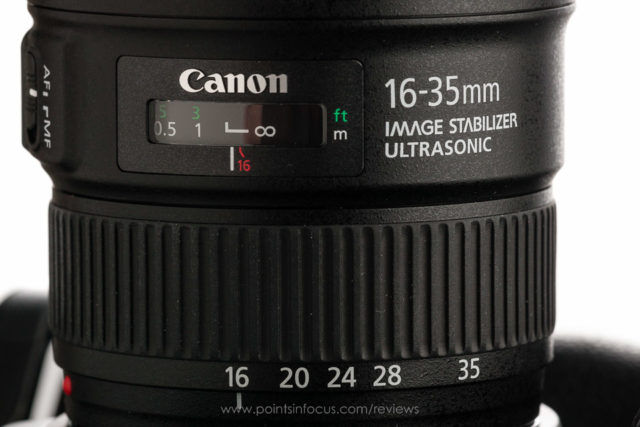
The ring on my lens is smooth and well damped. Compared to my copy of the 16–35mm f/2.8L II USM, the zoom action is much more uniform in both directions and relative to the angle of the lens. There’s no appreciable change in force needed to change the focal length regardless of whether the lens is pointing up, down, or is parallel to the ground.
Other Controls and Distance Scale
The EF 16–35mm f/4L IS USM doesn’t have an awful lot in the way of controls beyond the focus and zoom ring. There are two control switches, one of the AF system and one for the image stabilizer.
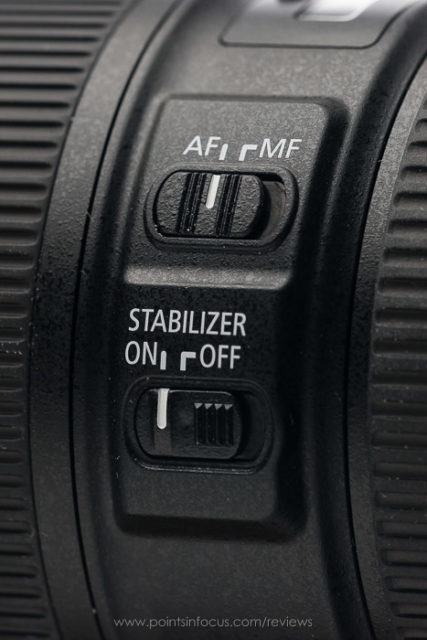
Since this is a ring-USM lens, it’s capable of full time manual focus. Therefore the AF switch is really only needed as a safety to disable the AF system completely when the AF is tied to the shutter release. Alternative, if you use rear button focusing, you can get away without ever taking the AF/MF switch out of AF unless you absolutely need to insure that the camera can’t alter the focus.
The second physical switch is the STABILIZER switch, which control the image stabilization system. The EF 16–35mm f/4L IS USM lens’s Image Stabilization system doesn’t provide user selectable modes — panning is detected and compensated for automatically — so there is only settings for turning the IS system on and off.
Finally there is a distance scale located on the top of the lens. It’s graduated in feet and meters, and like most ultra-wide angle zooms nearly useless for anything more than the vaguest notion of the focus distance. There is no depth of field scales or any other useful information on the distance scale, aside from a 16mm IR focusing compensation mark.
Personally, I’ve long since felt that traditional distance scales like the one on the EF 16–35mm f/4L IS USM have outlived their usefulness. An electronic replacement tied into the camera or through a display on the lens could provide far more information to the photographer than what can be conveyed through the scales currently used, especially on ultra-wide angle lenses.
Image Stabilization
This is the first ultra-wide angle zoom that I’ve worked with that is image stabilized. Canon advertises that the IS system is good for up to 4 stops of shutter speed when compensating for camera shake at 35mm. At shorter focal lengths, the IS system may be less effective.
The loss of IS “performance” is a byproduct of the extremely long exposures that would be cropping up with ultra-wide-angle lenses. Consider that using the handholding rule of thumb speed for 16mm (1/20s), 4 stops of IS would mean shooting for 0.8s.
I’m not even going to bother trying to quantify the performance that I’ve seen. The effectiveness of image stabilization is highly dependent on the photographer holding the camera and lens. The reality is how well an IS system ultimately works for any given photographer is going to depend heavily not only on their inherent stability, but also on their footing, stance, and technique.
As an example of this, Bryan Carnathan of the Digital Picture in his review reported reliably getting sharp frames at 1 and 2 seconds. I can’t even come close to matching that unless I focus a tremendous amount of energy on my breathing and technique. Even then, I often end up with blurred exposures from the simple act of pressing the shutter release, no matter how carefully I do it.
That said, the following images are an example of what the IS system is capable of when everything else lines up right.
In the broad picture, the IS system seems to do its job. In the informal testing I did conduct, I did see improved sharpness in images at shutter speeds below those suggested by the hand holding rule of thumb with the IS system enabled. Especially when shooting at 35mm as show in the 0.6s examples show above. However, at 16mm my success at such low shutter speeds is somewhat less consistent.
That said, when you start talking about shutter speeds in the 1/2 second range, there is no easy solution for sharp images without a tripod. You absolutely must have the best technique possible, and even then, you will likely move enough in the directions that the camera can’t compensate for (roll and fore–aft) that you’ll end up with motion blur in your images.
Finally a comment on IS modes and tripod detection. Most longer focal length stabilized lenses have a mode selection switch to select from static, panning, and now erratic tracking modes. This lens does not, and according to Canon it doesn’t need one either.
According to Canon[1] the lens will automatically detect if it’s being used in a panning situation and automatically switch to only compensating orthogonally to the direction of the pan.
The question of tripod detection is a bit more complicated. According to Canon’s Professional network page on image stabilization the EF 16–35mm f/4L IS USM does not detect if it’s on a tripod. However, according to the CPN product page under “Key Benefits”, Canon says the following.
It also includes tripod detection, switching off IS automatically when the camera is mounted on a tripod for optimum image quality.
The manual for the lens seems to support that position in a slightly round about way saying:
Set the STABILIZER switch to OFF when you are taking pictures with the Bulb setting (long exposures). If the STABILIZER switch is set to ON, the image stabilizer may introduce errors.
When you use a tripod, the Image Stabilizer should be turned off to conserve power.
You definitely will want to turn the IS system off if you’re shooting long exposures from a tripod, if only for the power saving reasons. For more normal exposures, say down to 1 second or so, shot from a tripod, I’ve not yet had a problem with leaving the IS system on. Though if I’m exclusively working from a tripod, I’ll still turn the IS system off again for the power conservation reasons.
Optical Performance
Quantitate analysis of lens performance is something I’m still not setup to do. However, I feel remiss for not at least taking a qualitative approach to the aspects I can address. If you’re looking for resolution numbers, I recommend DXOMark for that.
The good news is that this lens clearly demonstrates that Canon does get how to design and build wide and ultra-wide angle lenses. This has always been Canon’s weak area in lens design. The EF 16–35mm f/4L IS joins the recent collection of really good Canon wides, and is the first really good Canon wide zoom.
In fact, the not so insignificant increase in image quality — especially in the corners — is the only reason I switched from EF 16–35mm f/2.8L II USM to this lens. The good news is that it doesn’t take a resolution test chart to see the different in performance between this lens and it’s faster older sibling. The corners are considerably sharper.
Moreover, for night landscape photographers, coma is significantly better than EF 16–35mm f/2.8L II USM.
While there are still some coma, especially in the extreme corners, it’s much better than it was in the EF 16-35mm f/2.8L II USM.
Coatings and Flare
While Canon has a number of interesting and highly sophisticated nano-scale coatings, none appear have been used on the EF 16–35mm f/4L IS USM. What’s even more surprising is that even without the fancy coatings, the lens controls flare extremely well.
The other coating related point is that the outside surfaces of the front and rear elements are coated with an oleophobic fluorine based coating. Canon first started using this coating on their sensors to help reduce dust spots by causing oils to not stick to the sensors. They’ve since carried the technology to their lenses where it aids in helping keep the front and rear lens surfaces cleaner: making them less susceptible to smudging and finger prints.
Parfocal Stability
A lens is considered to be parfocal when the focus position doesn’t change when the lens’s zoom position is changed. This trait is desirable for video users as it allows them to zoom without having to refocus. For still photographers, the utility of a parfocal lens has largely been diminished by autofocus, and as such most modern still lenses aren’t designed to be parfocal.
Parfocal or not, it doesn’t really matter that much with the EF 16–35mm f/4L IS USM at normal working distances. As a wide to ultra-wide angle lens, there’s so much depth of field to work with that it’s almost impossible to notice any errors in focusing, even wide open at f/4.
| 16mm | 35mm |
|---|---|
 |
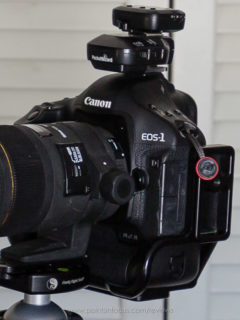 |
| 16mm | 35mm |
|---|---|
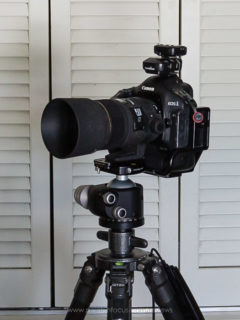 |
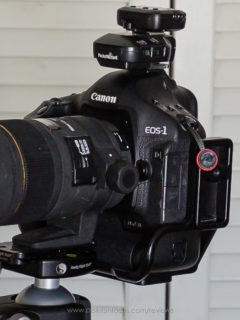 |
The above two images show the results focusing at 16mm and 35mm respectively, and then zooming to the other extreme. For those tests that subject distance was about 6 feet.
Breathing/Focus Focal Length Stability
The other video-centric consideration with lenses is breathing. Many inner and rear focusing lenses change focal length when they’re focused closer to the camera. In videography and cinematography this is called breathing as the edges of the frame seem to breathe when focus is racked back and forth between subjects.
This is generally not something that still photography lenses are designed to compensate for, and the EF 16–35mm f/4L IS USM, as show in the filter tests, is no exception there.
Fortunately give the lack of shallow depth of field and wide angle of this lens, breathing shouldn’t be much of a problem. Moreover, a full focus length pull like show in the tests isn’t something that’s going to be especially common in practice either.
Close Focus Distance/Maximum Magnification
Ultra-wide angle lenses usually can focus close, and the EF 16–35mm f/4L IS USM is not an exception to that. The minimum focusing distance is just over 11 inches (0.28m). Thats pretty much standard for an ultra-wide in this focal range.
Maximum magnification, on the other hand, is not the strong suit of ultra-wide angle zooms, at the 35mm position magnification is 0.23x.
Conclusion
The big question is, “Has Canon managed to make a wide angle lens that doesn’t make discerning users cringe?”
Fortunately the answer appears to be a resounding yes.
Lens Data
| Optical Specifications | |
| Focal Length | 16 mm — 35 mm |
| Angle of View (Full Frame) | Diagonal: 108°10′ – 63° Vertical: 74°10′ – 38° Horizontal: 98° – 54° |
| Min Focusing Distance | 0.28 m / 0.92 ft. |
| Max Magnification | 0.23x @ 35 mm |
| Max Aperture | f/4 |
| Min Aperture | f/22 |
| Max Aperture by Focal Length | f/4 at all focal lengths |
| T-Stop by Focal Length | t/4.5 @ 16 mm t/4.6 @ 20 mm t/4.5 @ 24 mm t/4.5 @ 28 mm t/4.6 @ 35 mm |
| Aperture Design | 9 blade, rounded |
| Optical Formula | 16 elements in 12 groups |
| Elements/Coatings | 2 UD, 3 Aspherical |
| Stabilized | Yes |
| Stabilizer Performance | 4 stops |
| Stabilizer Modes | On / Off |
| Breathes when Focusing | |
| Parfocal | No |
| Focus | |
| Focus Type | Rear |
| AF Type | Ring USM |
| Full Time Manual | Yes |
| Focus Ring Rotation | 80° from MFD stop to ∞ mark 91° from MFD stop to ∞ stop |
| E-TTL 2 Distance Info Provided | Yes |
| Distance Scale/Type | Yes, Window |
| Focus Limiter? / Positions | No |
| Zoom | |
| Type | Ring, Internal Zoom |
| Zoom Lock | Yes, at any focal length |
| Build | |
| Length | 4.44″ / 112.8 mm |
| Diameter | 3.25″ / 82.6 mm |
| Weight | 1.36 lbs. / 615 g |
| Material | Metal barrel, metal mount |
| Finish | Black |
| Filter Threads | 77mm |
| Weather Sealed | Yes with filter |
| Misc | |
| Lens Hood / Included | EW-82 |
| Tripod Ring Include / Removable | No |
| Extender Compatible | No |
| Case / Included | LP1219 / Yes |
| 2016 Camera AF Data (5D Mark 4, 1D X mark 2) | |
| AF Group: | C |
| AF Points: | All 61 active 21 central cross active, 20 edge cross types are active |
| Group Diagram(s) |  |
| 2012 Camera AF Data (5D Mark 3, 1D X) | |
| AF Group: | C |
| AF Points: | All 61 active 21 central cross active, 20 side cross active |
| Group Diagram(s) | 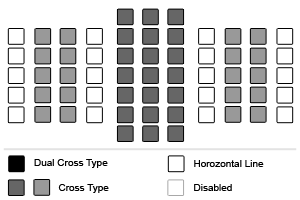 |
- CPN Product Page, EF 16–35mm f/4L IS USM manual, pp 1,9. ↩

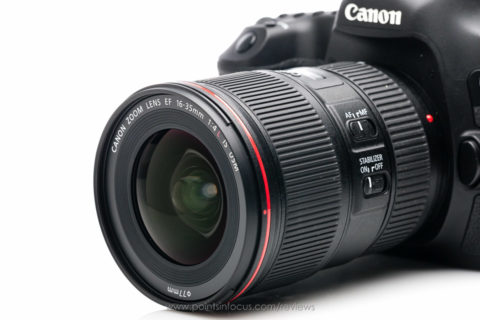
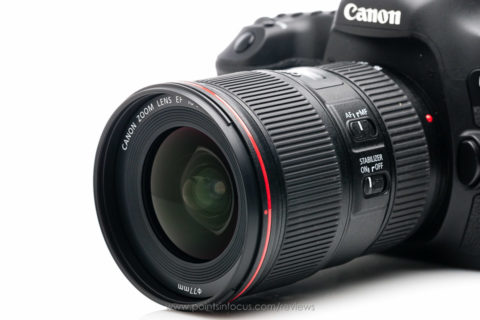
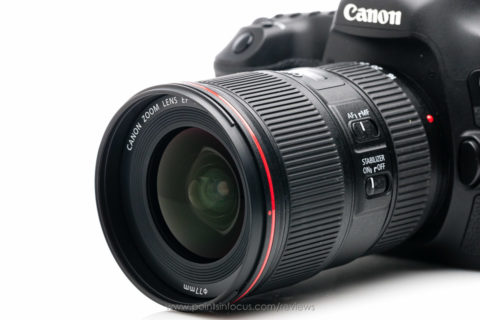
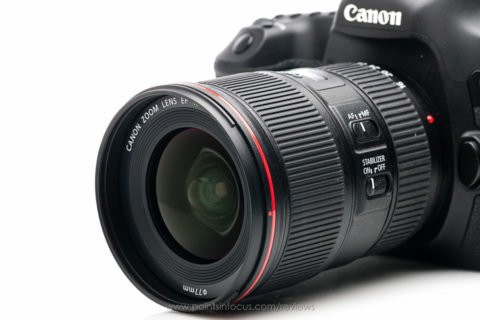
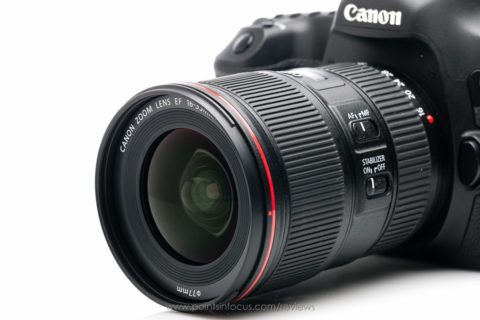

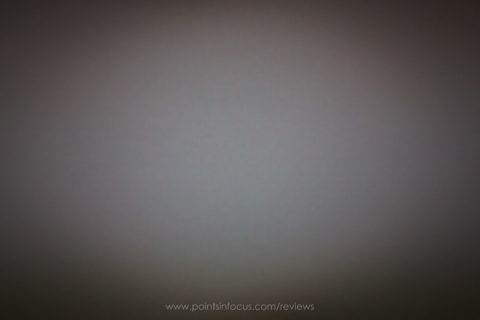
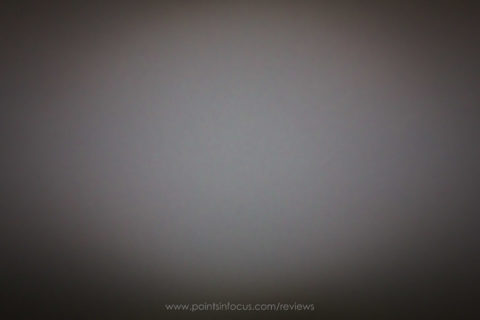
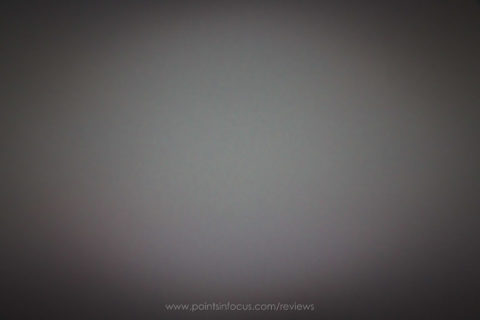
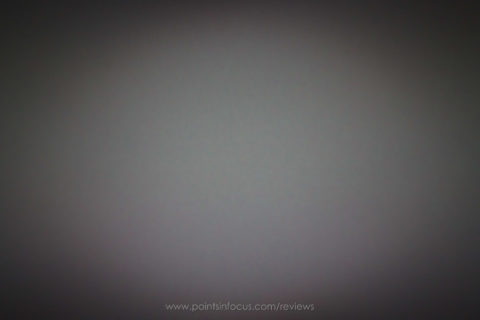
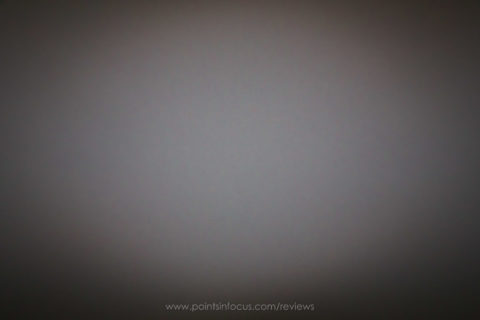
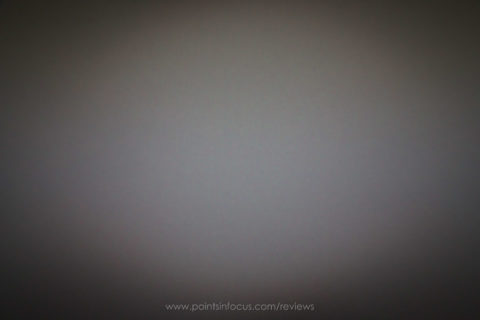
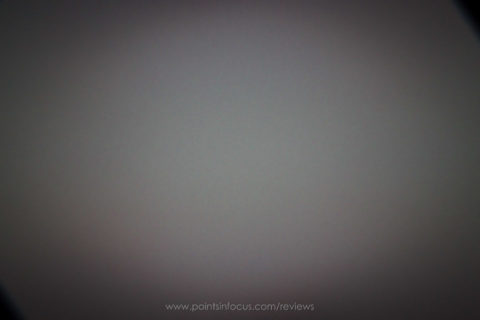
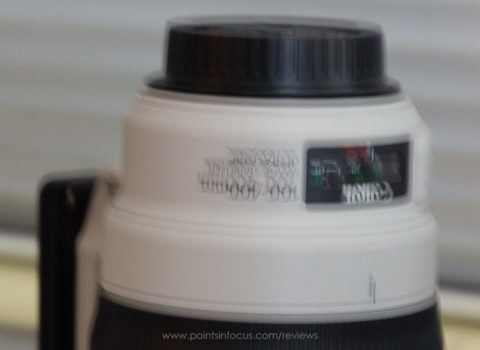
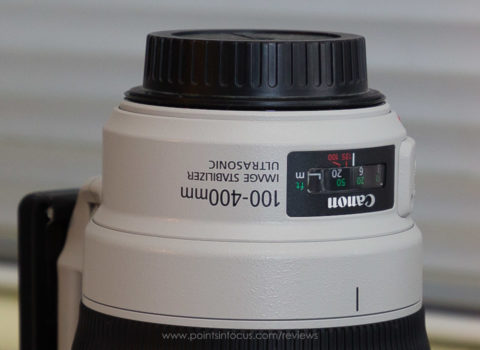

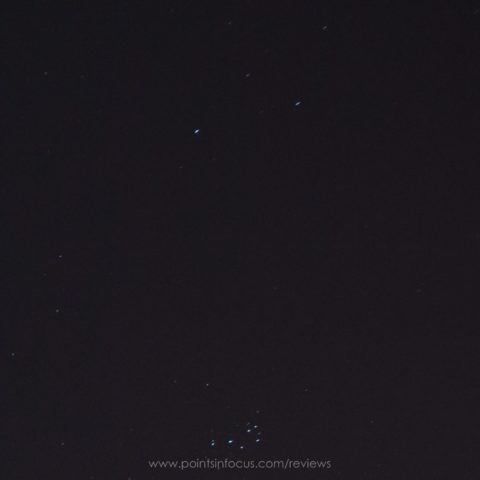
Comments
Can the canon lens hood for this lens be used with the xs-pro 77mm ? I read that some hoods cannot fit over the slim 3mm filter due to outside diameter of the filter being too large.
Len,
As far as I know both the hood and cap work fine with B+W’s XS-Pro filters. In fact, I have an XS-Pro protection filter on mine to complete the weather sealing.
Additionally, as far as I know, none of the B+W XS-Pro filters are any wider than a standard filter (X-Pro or other’s). They’re thinner, so they won’t vignette, or vignette as much, as standard thickness filters but their outer diameter is the same as a standard filter’s. At least this is true for the protection filters I’ve used, and the polarizers that I’ve seen.
I love the 16-35 F/4 but find it horrible at focusing with the 6D body at 16mm at distances greater than about 6-10′ in low light. It’s a common problem with ultrawides. A tentative solution I’ve arrived at, short of selling the lens and buy a 7D II, is to focus at 35mm where accurate focus is more likely (because the focusing spot is larger relative to the image size), and then hold the shutter buttom down while zooming to 16mm. If you can suggest a better way, I’d be very, very receptive (and grateful!). I wonder if it would be better not to use just the central focus spot, but use all nine. Hm, will have to try that. Or maybe just buy a D500 with focusing spots all over the blasted frame?
P.S. I experimented with focusing the 16-35 F/4 using the method I mentioned above – focusing on distant objects in low light (and daylight) at 35mm, then holding down the shutter button to maintain focus while zooming to 16mm. It works beautifully.
I’m really interested in how you’re defining “low light”?
To be completely honest, I’ve never had any problems getting the AF system to focus with any of my ultra-wides in really any lighting conditions. This goes back all the way to my 10-22 on my 40D.
Racking focus the way you are is certainly possible, at least with this lens given the depth of field, especially going to 16mm. That said, I would caution about getting in the habit of doing that in general, as the vast majority of modern zoom lenses intended for still photography will shift focus when you zoom. The 16-35/4L IS, and most ultra wides, are less susceptible to this at least in most cases because the deep depth of field wide angle lenses inherently have. For lenses where it works and you know it works, it’s fine to do. But be sure to test it thoroughly before trying it in general.
I don’t think throwing more AF points at the problem will help. To start with, the center point is the most accurate and sensitive. Anything else is going to be less so — even in a system that rates all points at the same sensitivity, the peripheral points will be subject to lower SNRs due to the lens’s vignetting. Moreover, based on my understanding of how multi-point AF systems work (though I certainly ought to test this) the points aren’t “combined” into one bigger more sensitive point, they’re still separate points working somewhat independently over a wider area.
I think I’ll have to throw a low light AF accuracy testing article into my to do list though… that could be interesting.
Hello Jason, and thanks for a very thoughtful reply. The venue where I often shoot requires exposing in the ballpark of 1/125 @ f/5.6 at ISO 4000. With the 135mm f/2 lens I can shoot events in the same location at f/2 @ 1/640 to 1/1250 and never miss focus. But the 16-35mm f/4 NEVER nails focus using the central focusing spot in single-focus mode. On the other hand, outdoors in good light the 16-35 focuses reliably.
The Canon 6D is notoriously poor at focusing in low light, allegedly because of its single cross-type focusing point – see Jared Pohlin’s review – “The Canon 6D is the PERFECT camera except for one fatal flaw.” (http://froknowsphoto.com/canon-6d-review/)
I had similar problems shooting with a Nikon D7000 and a Tokina 12-28mm f/2.8 lens – but again, only when shooting at a distance; close-up, it focused perfectly.
An article that first gave me a clue about the issue was: http://www.prime-junta.net/pont/How_to/m_Mastering_Wide-Angle/m_Mastering_Wide-Angle.html. In his intro to the section on focusing problems with wide-angle lenses, he says:
“A second complication is that auto-focus really doesn’t work that well with wide-angle. Especially with the shorter, darker lenses hyperfocal distance wide-open is really quite close. Moreover, objects even a few meters away may be quite small in the frame, while the AF sensors are quite large. This means that AF will have real trouble latching onto anything more than a few meters away. (Top-end cameras with high-precision AF sensors are probably noticeably better at this, but even they can’t solve the problem; only mitigate it.)”
I’m guessing that using an ultrawide with the 6D to photograph a cattle stampede at sundown is a non-starter barring flash. Fortunately, for most of my stuff focusing at 35mm and pulling back will work (for subjects farther than about 6′). For close subjects even in low light focusing is a lot more reliable. Not a perfect solution, but it’s the best I can think of for now. I guess bounce flash would be another option.
Jason, thanks again for pointing out that focusing, then zooming, can shift the focus away from the subject with modern ultrawide zooms. In my brief testing, it didn’t happen with the 16-35/4, at least not noticeably at all, even when I displayed the photos at 100 percent. I compared photos where I let the camera decide on the focus, with photos where I focused at 35mm then zoomed to 16mm. With photos taken in low light indoors (a photo on a wall at about 5m), or taken outdoors at a distance (a garage door at about 75m), the first photos were mushy in both cases, and the second photos were sharp. I can’t explain it theoretically, but I’m happy that it works! :)
It’s not just modern ultra-wide zooms, it’s all zooms not specifically designed to not compensate for the shift in focus (which is virtually all still lens designs since the end of manual focus, and a good bit of the still lenses designed for manual focus). About the only lenses that are consistently designed not to shift focus when zoomed are cine lenses.
Like I said, and as I showed in this article where I tested it, you can do this with the 16-35/4L IS USM largely because the shift (if there is any) is much smaller than the available depth of field at normal working distances (I tested at 6 feet, it may be a problem at the minimum focus distance but then you’re also unlikely to need to focus at the longer focal length there too).
My point was more that if you wanted to try and apply that technique to other lenses (like says you rent/bought a 16-35/2.8L III or a Sigma 12-24/4) you would need to test to insure that that model would’t shift unacceptably and not just assume it would.
Ah, now I understand. Thanks for the explanation. Slightly off topic, but it’s beyond my comprehension how ultrawide lenses seem to behave very differently when it comes to the best way to focus them.
In a Thomas Heaton YouTube video (he’s a very popular landscape photographer), he tests his ultrawide to see whether focusing at the hyperfocal distance, or focusing at infinity, delivers the best sharpness throughout the image.
The clear conclusion, for that lens, is that focusing at infinity always produces the best image-wide sharpness. Completely different behavior than my 16-35 F/4. I have no clue why that would happen.
I suspect, that the best explanation of the problems with focusing UWA lenses at their widest settings is a combination of Petteri Sulonen’s (your second link form before) statement that it makes the details appear smaller, and thus are harder for the AF sensor to pick up, and the differences in the “optical geometry” (for lack of a better word) in the way/angle of the light from the very short focal lengths is incident on the AF sensor’s pixels.
As I said, I’ve never personally seen problem with my 16-35/4 and focusing, but I’ve only ever used it on my 5D mark III and IV which very well may have sensitive enough AF systems to mask the issues you’re seeing.
Hyperfocal focusing, well… Depth of field and the hyperfocal distance come with a lot of baggage in the form of assumptions about what will be acceptably in focus. Many of those assumptions worked fine with film and the limits that it imposed on photographers, but they fall apart quite under digital for various reasons.
Jason, thank you once again. This is very helpful information. Meanwhile, I’ve heard from 6D owners who report that their cameras have no problem focusing with this lens in low light. I guess I’ll need to send it to Canon for a check-up.